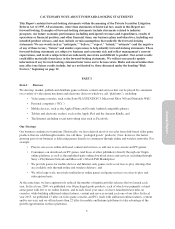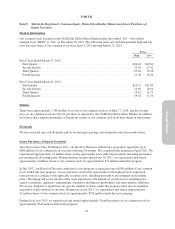Electronic Arts 2013 Annual Report Download - page 97
Download and view the complete annual report
Please find page 97 of the 2013 Electronic Arts annual report below. You can navigate through the pages in the report by either clicking on the pages listed below, or by using the keyword search tool below to find specific information within the annual report.
Annual Report
Our industry is cyclical, driven by the periodic introduction of new video game hardware systems. As
consumers transition to new console platforms, our operating results may be more volatile.
New video game hardware systems have historically been developed and released every few years, which causes
the video game software market to be cyclical as well. The current cycle began with Microsoft’s launch of the
Xbox 360 in 2005, and continued in 2006 when Sony and Nintendo launched the PLAYSTATION 3 and the Wii,
respectively. Both Microsoft and Sony have announced their plans to release new video game console systems in
2013. In November 2012, Nintendo released its WiiU, which succeeded the Wii. Recently, we have seen a
decline in the market for current-generation video game systems, which we believe is being caused by consumers
awaiting the availability of new console systems from Sony and Microsoft. This decline in sales of current-
generation video game systems has caused a corresponding decline in the sales of packaged goods video game
software for those systems.
In the near term, we expect to develop and market products and services for current-generation consoles
including the Xbox 360 and PLAYSTATION 3, while also developing products and services for next-generation
console systems. We do not control the introduction of these new console systems, nor can we predict with
certainty the unit volumes of these new console systems that will be available at launch, or the rate at which
consumers will purchase these new console systems. As a result, our operating results during this transitional
period may be more volatile and will be difficult to predict.
Our business is dependent on the success and availability of video game hardware systems manufactured
by third parties, as well as our ability to develop commercially successful products and services for these
systems.
The success of our business is driven in part by the commercial success and adequate supply of these video game
systems, personal computers and mobile phones/devices manufactured by third parties (which we refer to as
“platforms”). Our success also depends on our ability to accurately predict which platforms will be successful in
the marketplace, and our ability to develop commercially successful products and services for these platforms.
We must make product development decisions and commit significant resources well in advance of anticipated
platform release dates. A platform for which we are developing products and services may not succeed or may
have a shorter life cycle than anticipated. If consumer demand for the platforms for which we are developing
products and services is lower than our expectations, our revenue will suffer, we may be unable to fully recover
the investments we have made in developing our products and services, and our financial performance will be
harmed. Alternatively, a platform for which we have not devoted significant resources could be more successful
than we had initially anticipated, causing us to miss out on meaningful revenue opportunities.
Our adoption of new business models could fail to produce our desired financial returns.
We are actively seeking to monetize game properties through a variety of new platforms and business models,
including online distribution of full games and additional content, free-to-play games supported by advertising
and/or micro-transactions on social networking services and subscription services. Forecasting our revenues and
profitability for these new business models is inherently uncertain and volatile. Our actual revenues and profits
for these businesses may be significantly greater or less than our forecasts. Additionally, these new business
models could fail for one or more of our titles, resulting in the loss of our investment in the development and
infrastructure needed to support these new business models, and the opportunity cost of diverting management
and financial resources away from more successful businesses.
Technology changes rapidly in our business and if we fail to anticipate or successfully develop games for
new platforms and services, adopt new distribution technologies or methods, or implement new
technologies in our games, the quality, timeliness and competitiveness of our products and services will
suffer.
Rapid technology changes in our industry require us to anticipate, sometimes years in advance, which
technologies we must implement and take advantage of in order to make our products and services competitive in
13
























